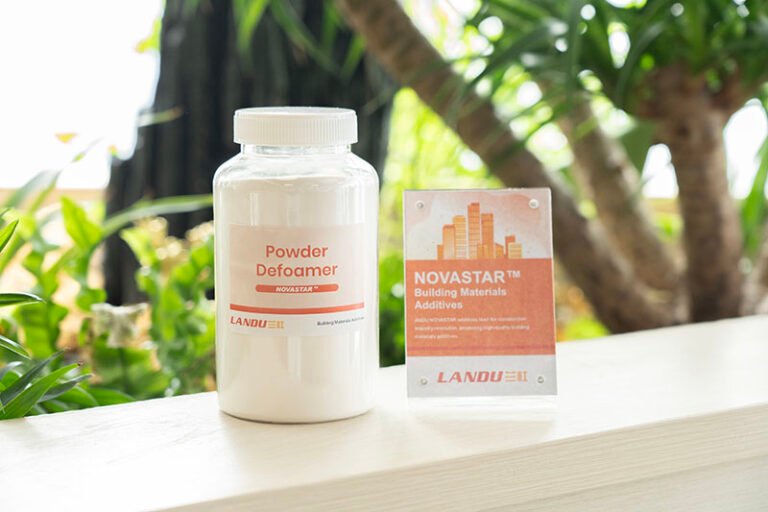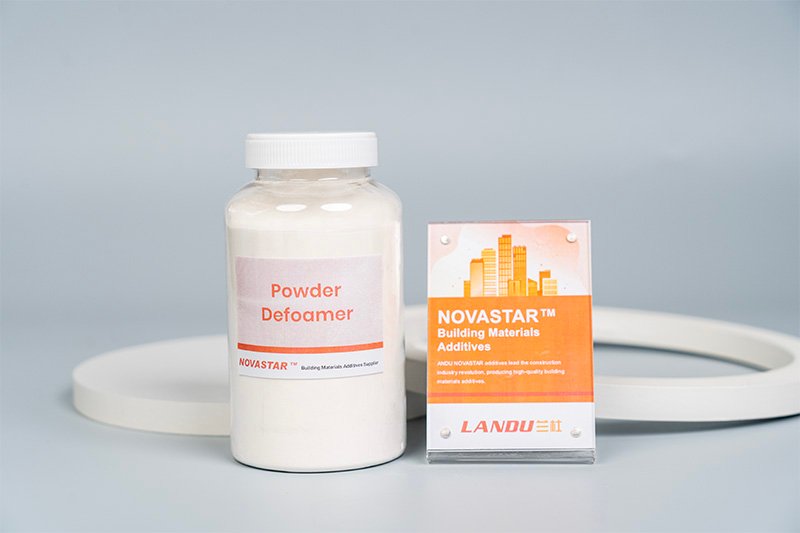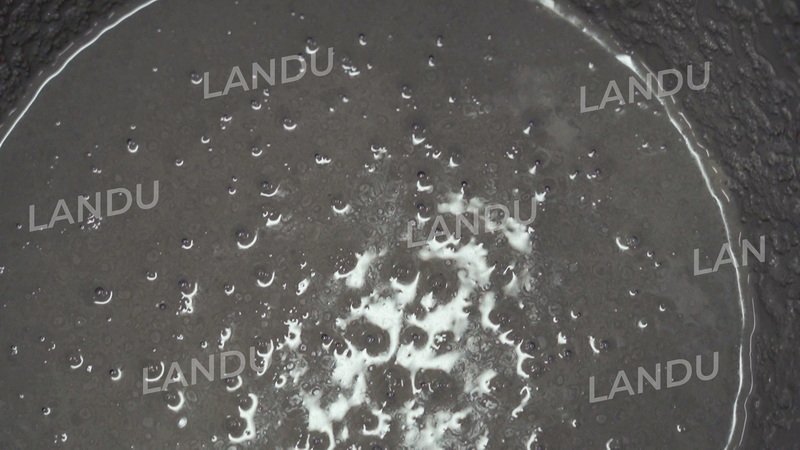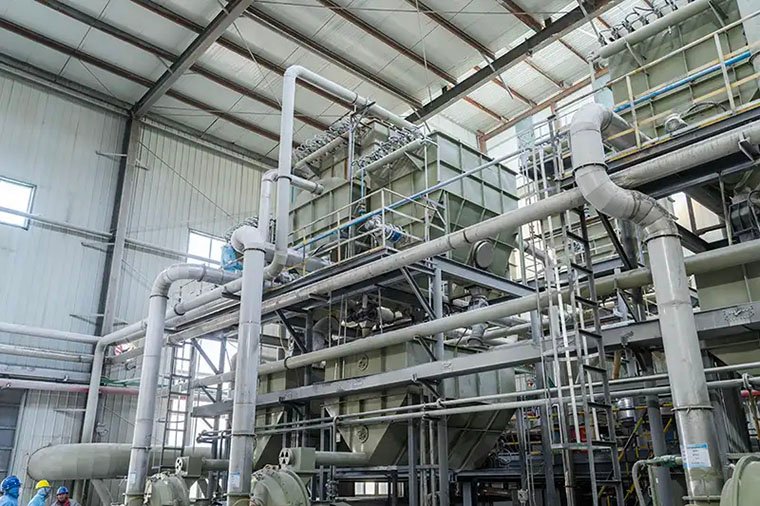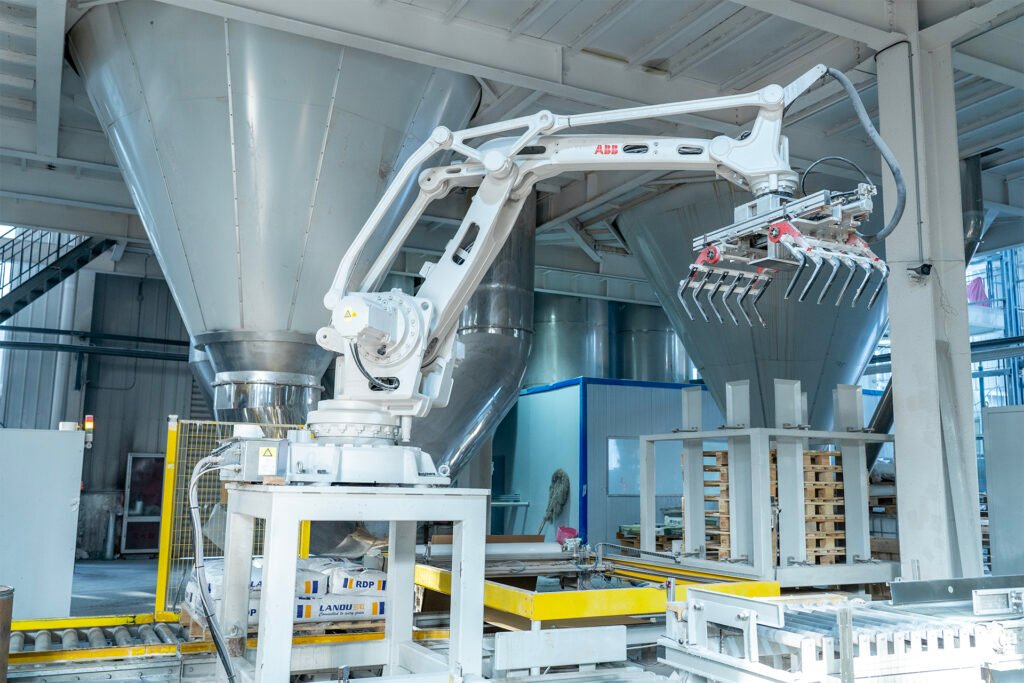Executive Summary
A defoamer agent (frequently synonymous with “antifoam”) serves as a specialized component crafted to eradicate present foam or hinder its emergence in fluid setups. By managing both large-scale foam (evident bubbles) and small-scale foam (trapped air lingering as voids or cloudiness), these agents enhance operations, exterior excellence, and end-item outcomes. LANDU defoamer agents are designed for rigorous settings—cement mixtures, surface layers, chemical handling, hydration management, pulp processing—where elevated acidity, vigorous agitation, solids, ions, or heat variations test standard options. This overview elucidates defoamer functionality, selection of apt molecular types, dosing locations and methods, evaluation and diagnostics, and incorporation into contemporary blends sans undermining robustness, attachment, shine, or reliability.
This in-depth discussion bridges defoamer science to actionable blending advice for highlighted fields: building substances, surface formulations, chemical operations, hydration oversight, and pulp sectors. Readers will uncover practical insights on functionality in wet environments; how molecular makeup, hydrophobicity, and endurance mold outcomes; strategies for variant choice and measurement; and integrations with enhancers like dispersants, densifiers, and stabilizers. Additional segments address preparation and validation routines, environmental adaptations, failure diagnostics with remedies, illustrative examples, rollout blueprints, and economic value analyses. The goal is dependable, reproducible site successes with scarcer flaws, lowered adjustments, and optimized workflows.
1) Foam Essentials: Origins and Importance
Foam constitutes a spread of gas within a liquid, steadied by exterior-active elements. It appears as:
- Large-scale foam: Big, visible bubbles on the top.
- Small-scale foam/trapped gas: Tiny bubbles scattered in the mass that resist breakdown but may surface later as pits, voids, or compactness loss.
Main Triggers
- Surfactants and separators that fortify gas-liquid boundaries (prevalent in layers and enhancers).
- Vigorous agitation and transfer that introduce gas quicker than it disperses.
- Elevated thickness that delays bubble ascent and rupture.
- Granular webs that ensnare bubbles (e.g., cement, bulks, colorants, fiber strands).
- Operational factors (heat, acidity, dissolved vapors) that alter exterior pull and draining.
Why Foam Oversight Matters
- Building substances: Abundant gas reduces wet compactness and robustness, weakens attachment, and triggers exterior flaws (voids, pits, pits). In a mortar spread on absorbent stone, unchecked foam could cause uneven sets, compromising structural integrity.
- Surface formulations: Foam generates pits, flaws, texture irregularities, and shine reduction; it complicates hue reception and density control, leading to costly reworks in architectural finishes.
- Chemical operations: Foam induces pump failures, vessel overflows, sensor errors, lowered heat swap, and hidden corrosion in hydration setups.
- Pulp & fiber: Foam interrupts draining, sheet creation, and coating; amps interruptions and chemical wastes, inflating costs in high-speed mills.
Imagine a bustling plant where foam halts lines—productivity plummets, safety risks rise, and waste mounts. Effective defoamers transform these disruptions into seamless flows, aligning with demands for efficiency and sustainability in modern industries.
2) Defoamer Functionality: Core Principles
Potent defoamers merge energy laws (exterior force) and boundary science (layer draining and break):
Exterior pull cutback at bubble boundaries: A drop with adequately low pull expands on the foam layer, displacing steadying surfactant and fostering thinning and break.
Penetration and expansion: For a defoamer drop to operate, it must penetrate the gas-water boundary (favorable penetration factor), then expand (favorable expansion factor). Aptly refined oils/waxes and granule loads guarantee both.
Linking-dewetting through repellents: Finely spread repellent solids (e.g., treated mineral, wax particles) transported by an oil stage pierce foam layers, locally “link” boundaries, and initiate dewetting and layer collapse.
Flow effects: Local exterior pull gradients formed by the agent propel boundary movement that unstabilizes the foam layer and hastens break.
Prevention action: Undissolvable drops in the fluid stage disrupt bubble steadiness at formation; they also foster bubble merging so tiny bubbles combine and flee more easily.
These principles vary by setup— in high-acidity cement, defoamers must withstand ions to persist; in layers, they need to avoid craters while collapsing foam. Rhetorically, why settle for reactive fixes when proactive defoamers prevent issues altogether?
3) Defoamer Molecular Types: Advantages, Compromises, and Fits
Varied molecular types are refined for particular setups and operational spans. LANDU formulates and merges these groups to address usage-specific demands.
Oil-based (with repellent granules)
- Advantages: Wide utility, solid value, durable in neutral to moderate basic setups, potent in many aqueous layers and chemical operations.
- Cautions: May impact clarity and bear scent; excess can trigger pits in high-shine layers.
Silicone-based (chain, emulsions, silicone-mineral)
- Advantages: Highly potent at low measures; effective over broad heat/acidity; quick reduction of persistent foam; superior in fermentation, waste oversight, vigorous agitation setups.
- Cautions: Over-measure can cause exterior flaws (pits, defects) in layers; potential film blockage in filtration if not chosen carefully; poor re-layerability if mismatched.
Glycol polymers and block copolymers
- Advantages: Solid harmony in many layers and bonds; lesser pit risk; low scent; effective small-foam control.
- Cautions: Less aggressive reduction than silicone; outcomes depend on heat and ion strength.
Synthetic carbons and esters (including degradable oils)
- Advantages: Food-touch or eco options feasible; balanced reduction and persistence; adjustable for high-solids.
- Cautions: May need higher measure than silicone; endurance can hinge on emulsion excellence.
Powder forms (for dry blends)
- Makeup: Repellent carriers (e.g., waxes/oils) fixed on mineral/organic bases or repellent mineral.
- Advantages: Spread evenly in dry combinations (binders, attachments, coatings); activate on wetting; consistent site measuring.
- Cautions: Must endure storage sans shift or clumping; activation relies on blending energy and liquid heat.
4) Uses and Gains
4.1 Building Substances (Cement Fluids, Binders, Fills, Exteriors, Attachments, Thin Layers, Self-Evening Bases)
Aims
- Reduce trapped gas to design levels sans usability loss.
- Eradicate exterior voids/pits, boundary pits, and “foam lines.”
- Preserve robustness, attachment, and conclusion while managing liquid need.
Defoamer Aid
- Lessen small-foam from flow boosters, cellulose, and RDP in polymer-refined binders.
- Better wet compactness, leading to higher press robustness and superior detachment attachment.
- Enable smoother spreading sensation and tidier exteriors, especially in thin and self-evening setups.
Standard Initial Measure (by Dry Blend Mass)
- 0.02–0.10% for most dry binders and attachments (powder form).
- 0.05–0.30% for wet-added in fills/fluids, per type and gas goal.
Integration Advice
- For dry: Pre-mix powder uniformly with bulks to avoid local excess. Check storage endurance across seasons.
- For wet: Add to mix liquid or post-initial wetting; permit short pause and re-mix to activate. Shun excess vigorous post-goal thickness (re-introduces gas).
Key Validation Checks
- Wet compactness/gas levels, flow/settling, exterior inspection for voids/pits, press/pull attachment.
4.2 Surface Formulations and Layers (Architectural, Industrial, Wood Conclusions, Inks, Bonds)
Aims
- Quick foam reduction in grind and final mix.
- Small-foam oversight during placement sans pits or shine loss.
- Preservation reliability sans density drift or division.
Defoamer Aid
- Better pigment grind potency, lessen gas during separation.
- Deliver smooth, bubble-free layers with optimal droop-even equilibrium when matched with right flow package.
Standard Initial Measure (as Supplied, on Total Blend)
- 0.05–0.30% for silicone-containing in high-solids or high-load setups.
- 0.10–0.50% for silicone-free in sensitive high-shine or re-layer critical setups.
Integration Advice
- Add part early (grind) for wetting/separation and part at final for placement foam; consider post-add for site-tuned.
- Match to binder and surfactant; mismatched silicone can cause pits or inter-layer issues.
Key Validation Checks
- Grind fineness, densities, shine/haze, drawdown flaws (pits, defects), preservation reliability (heat/cold cycles), small-foam post-roll/mist.
4.3 Chemical Operations and Hydration Oversight (Cooling, Waste Aeration, Process Vessels, Pulp and Fiber)
Aims
- Prevent vessel over-foam, false levels, and pump failures.
- Sustain heat swap and throughput.
- Reduce chemical carry and hidden corrosion.
Defoamer Aid
- Provide rapid collapse in aeration, clarifiers, and machines.
- Keep suspended solids spread to avert deposit buildup on exteriors.
Standard Initial Measure (Active Polymer)
- 5–50 mg/L in hydration and vessels (adjust to load and gas rate).
- 10–500 ppm in pulp; continuous or shock per speed and makeup.
Integration Advice
- Feed at high-turmoil pre-foam zone; avoid dead areas.
- Select filtration-harmonious upstream of films; shun high carry if fouling concern.
Key Validation Checks
- Foam height/decay, approach temperature/drop in exchangers, carry to downstream, deposit inspections.
5) Choice Guide: Matching Defoamer to Setup
Pose these to converge on optimal:
- Medium and acidity: Cement (high), layers (moderate), hydration (low) each narrow types.
- Solids and thickness: High-solids need durable, persistent; low-thickness favor quick reduction.
- Surfactant and enhancers: Strong loads can bind weak defoamers.
- Heat and agitation: Elevated heat speeds merging; high agitation can break or re-introduce.
- Regulatory/harmony: Food-touch, low-emission, silicone-free, or film-harmonious may dictate.
- Exterior sensitivity: High-shine prefer silicone-free or micro-structured to minimize pitting.
- Delivery form: Powder vs. liquid; emulsion vs. solvent; pre-diluted vs. neat—for plant practicality and preservation.
6) Measuring and Add Strategy
- Start low: Potent; begin at low window end and titrate based on gas/foam and visuals.
- Split measuring: For layers and complex, split between early and late to balance reduction and persistence.
- Pre-dilution: Benefit from in matching carrier to better distribution and minimize local over.
- Agitation oversight: High during or post-add can re-introduce or break drops; adjust speed post-goal thickness.
- Process location: Feed at turmoil (discharge, high-zone entry) for rapid spread; in vessels, avoid stagnant.
7) Evaluation Routines: Lab to Plant
No single assay predicts all site behavior; combine for robust view.
Column assays (static/dynamic)
- What: Aerate under gas flow and measure height, decay, half-life pre/post defoamer.
- Why: Quick screening; good for hydration/operations.
Vigorous mixer assays
- What: Agitate at rpm; measure trapped gas (compactness), foam volume, collapse with variants.
- Why: Emulates mixers for binders, layers, bonds.
Flow/density with gas levels
- What: Track density and compactness/gas to see if control alters movement.
- Why: Ensures usability or placement flow preserved.
Application panels (layers)
- What: Evaluate pits, defects, small-foam, shine, evening under conditions.
- Why: Detects sensitivity issues early.
Binder assays
- What: Wet compactness/gas, flow/settling, exterior voids, press/pull (as relevant).
- Why: Balances control with robustness/attachment goals.
Simulations
- What: Bench aeration or loops for hydration and pulp; measure tendency and decay under cycling.
- Why: Captures persistence and re-foam in real.
8) Problem-Solving Guide
Building Substances
Sign: Persistent voids or high gas
- Triggers: Insufficient measure/strength; late add post-stabilization; excess energy.
- Remedies: Up measure in window; move earlier; use aggressive type; cut post-thickness vigorous.
Sign: Robustness or attachment drop
- Triggers: Over-measuring or mismatch with modifiers.
- Remedies: Cut measure; re-balance booster and liquid; screen lower-impact (polymer-based) or powder optimized for modified setups.
Sign: Exterior pits post-spreading
- Triggers: Mismatched silicone or local over.
- Remedies: Pre-dilute for better spread; switch to free or low-pit; adjust surfactant.
Surface Formulations
Chemical Hydration and Pulp
